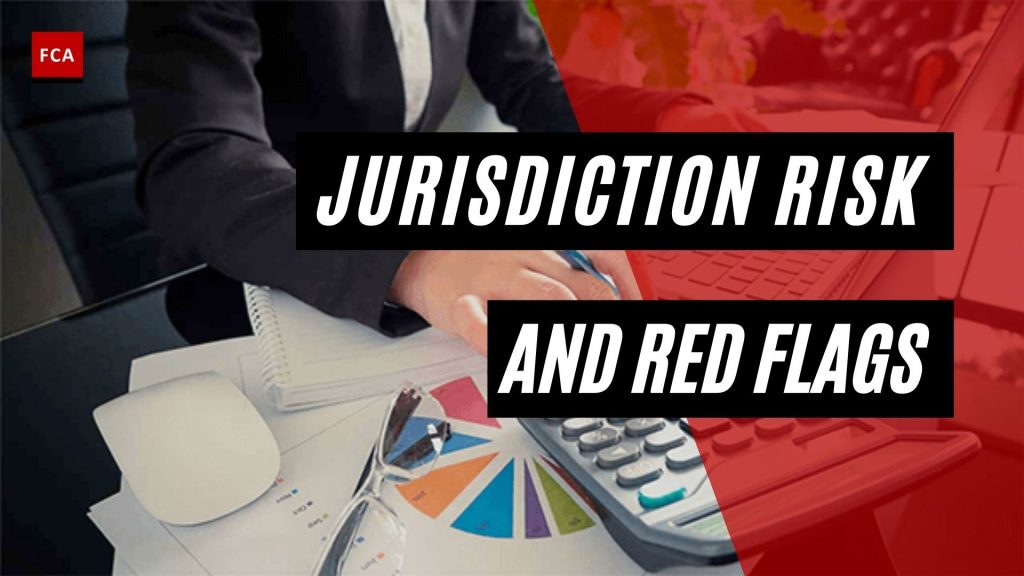The jurisdiction risk and red flags. The phrase «jurisdiction risk» has traditionally referred to the additional risk posed by investing in or lending cross-border to a foreign country.

The Jurisdiction Risk And Red Flags
Customers of the company may be from several jurisdictions or have commercial dealings with residents from many jurisdictions. This increases the risk of ML/TF since the nation or jurisdiction to which the consumers belong or with which they have business contacts may have weak or inadequate AML/KYC procedures.
The RBA was established as the overarching principle in the battle against money laundering and financial crime, and jurisdiction risk criteria were recognized as being significant in assessing the customer’s financial crime risk.
A customer’s nation of incorporation, domicile, center of operation, or tax residence might all be considered country considerations. As a result, while analyzing a customer’s risk profile, businesses must evaluate the customer’s financial crime risk as well as the customer’s source of wealth. In assessing ML/TF risks, the efficiency of legislative frameworks, as well as the political context of the nations, must be taken into account.
FIs need to ensure that the control environment of the country concerning AML / CFT must be appropriately and robust to manage the ML/TF risks.
Initial Understanding Of The Country’s Risks
The effective assessment of an organization’s financial crime country risk (FCCR) rating is based on the initial understanding of the country’s risks to which the customers belong. These may cover:
- The nature and extent of money laundering, terrorist financing, corruption, tax evasion risks, amongst others;
- Factors that could significantly influence the effectiveness of a country’s anti-money laundering (AML) and counter-terrorist financing (CTF) measures, including the maturity and sophistication of the regulatory and supervisory regime in the country;
- Legal AML/CTF frameworks;
- Structural elements which underpin the AML/CTF system, for example, political stability; a high-level commitment to address AML/CTF issues, and indicators of financial secrecy;
- The circumstances of the country, for example, the relative importance of different parts of the financial sector, the extent to which the economy is cash-based; estimates of the size of the informal sector and/or shadow economy;
- Other geographical factors such as trading or cultural links, or what are commonly known as nexus risks, where geographic proximity may drive a higher risk rating; this is particularly true for sanctions and terrorist financing considerations.
An organization’s assessment of the country’s risk is subject to factors beyond its control. However, once an organization has defined and validated its FCCR methodology, then it should be used as widely and consistently as possible to inform decisions where country risk is a required factor. Generally, an FCCR methodology is used for all business lines and related activities.
Relevant Risk Parameters Or Dimensions
Most country risk assessments incorporate both subjective and objective/ quantified data. The sources used for quantitative risk scoring should cover financial crime relevant risk parameters or dimensions such as:
- Criminal Indicators: such as corruption indices, political risk maps, countries considered to be tax havens, drug corridors, countries susceptible to human trafficking and terrorism, amongst others;
- Political Factors: such as political stability, levels of democratization, rule of law, human rights considerations, freedom of the press, civil liberties, amongst others;
- Regulatory Factors: expectations from home and host regulators about how to categorize countries from a financial crime risk management perspective, as well as how AML/CTF regimes are assessed by relevant third parties (for example, FATF Mutual Evaluations Reports).
It is appropriate to update the FCCR ratings on an annual basis, considering the underlying data related to the country. It is important to choose the current data.
The organization’s default sanctioned regimes to the highest risk banding in their country’s risk methodology. These countries may be in violation of applicable laws, including international laws and have made little progress towards complying with international mandates such as from the UN. The regulators expect that an organization’s relationships with its customers associated with sanctioned countries are subject to the highest levels of due diligence and onboarding approvals.
An organization’s presence may determine which economic and trade sanctions it should comply with and then source a list of sanctioned regimes from individual regulators’ portals/ websites. It is important to consider the reasons why certain countries are sanctioned, what risks are present, and how that is linked to financial crime.
For example, if the cause for sanctions is terrorism and terrorist financing, then the methodology needs to consider what data is used to measure the risk of terrorist financing.
An organization may face hazards while doing business in a foreign country; therefore, appropriate country ML/TF risk assessment helps in taking precautionary AML measures before doing or establishing a relationship with customers residing in such high-risk category countries.
Red Flags
Below are the jurisdiction risks related examples of red flags, which require review and investigations:
- The deposit of substantial amounts from an account maintained in another jurisdiction;
- The refusal to provide CDD documentation on beneficial owners/controllers;
- The frequency with which deposits are made from another jurisdiction that is inconsistent with the financial institution’s understanding of the customer;
- Payments received from or requests to make payments to a high-risk jurisdiction;
- The client is unable or unwilling to give information or plausible reasons to establish a business relationship, in a high-risk jurisdiction;
- For no prominent business or another purpose, the client maintains a large number of accounts in a high-risk jurisdiction.
Money Laundering And Terrorist Financing Red Flags
The following are some examples of potentially suspicious activities, or «red flags,» for money laundering and terrorist financing. Although these lists are not exhaustive, they may assist banks and examiners in identifying potential money laundering and terrorist financing schemes. FinCEN issues advisories with examples of «red flags» in order to inform and assist banks in reporting suspected money laundering, terrorist financing, and fraud. FinCEN requests that banks check the appropriate box(es) in the Suspicious Activity Information section and include certain key terms in the narrative section of the SAR in order to assist law enforcement in its efforts to target these activities.
Final Thoughts
Money laundering causes harm to organizations and countries in a variety of ways. Allowing money laundering through your business may result in high legal costs if the authorities discover it. Every year, criminals launder millions of dollars in «dirty» money, and many are apprehended. To protect your business from financial crimes and penalties from Anti-Money Laundering Regulators, it is critical to be aware of the red flag indicators that indicate illegal activities.








